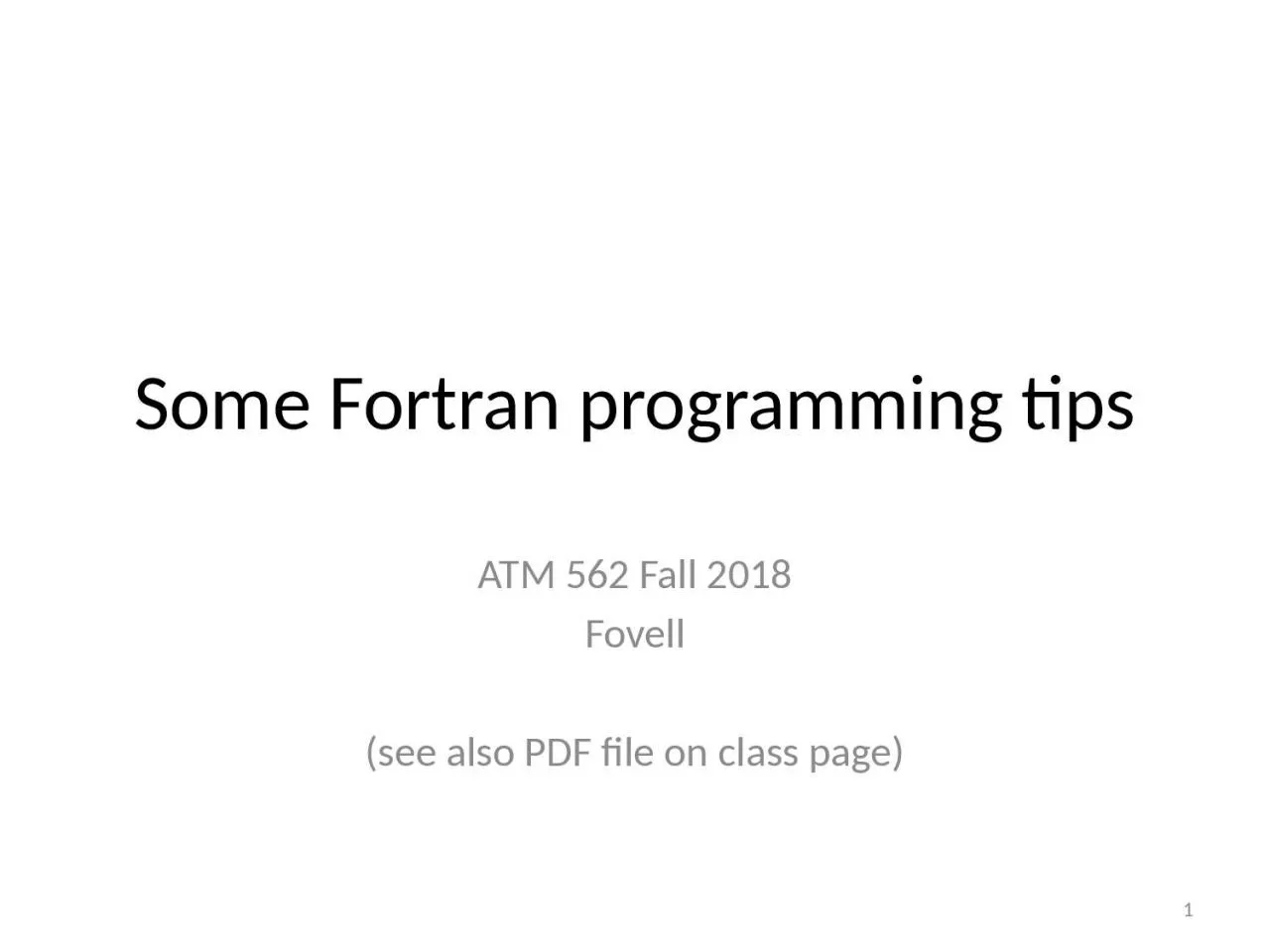

ATM 562 Fall 2018 Fovell see also PDF file on class page 1 Background Fortran derived from formula translation and emphasizes letting math look like math Fortran is NOT case sensitive ID: 1028282
Download Presentation The PPT/PDF document "Some Fortran programming tips" is the property of its rightful owner. Permission is granted to download and print the materials on this web site for personal, non-commercial use only, and to display it on your personal computer provided you do not modify the materials and that you retain all copyright notices contained in the materials. By downloading content from our website, you accept the terms of this agreement.
1. Some Fortran programming tipsATM 562 Fall 2018Fovell(see also PDF file on class page)1
2. Background“Fortran” derived from “formula translation”, and emphasizes letting “math look like math”.Fortran is NOT case sensitive.Variables assumed real, unless the first letter of the variable name starts with the letters I-N, inclusive. Then they're integers by default. (Mnemonic device: I-N are INtegers).Fortran 90+ permits free format. Fortran 77 (F77) statements start in column 7, with column 6 for continuation markers, and cols 1-5 for labels.Comment lines start with “C”, “c”, or “!”. Anything after “!”, wherever it appears, is not read.2
3. ArraysArrays are indexed from 1, unless otherwise specified. Array indices must be integers. parameter(nx=50,ny=40,nz=25) dimension pressure(nx,ny,nz),height(0:nz) do k=1,nz do j=1,ny do i=1,nx pressure(i,j,k) = [do something here] enddo ! i enddo ! j enddo ! k Fortran is column-major, which means it’s more efficient to put leftmost index in innermost loop (as here).C++ and Python (Numpy) are row-major3
4. More on arraysIf arrays are the same shape, can manipulate entire arrays outside of do loops parameter(nx=50,nz=40) dimension pi(nx,nz),temp(nx,nz),theta(nx,nz)! This… do k=1,nz do i=1,nx temp(i,k)=theta(i,k)*pi(i,k) enddo enddo! …is equivalent to this… temp=theta*pi 4
5. A sample Fortran program(F77-ish syntax)5
6. program example ! this is optional, actually ! non-executable statements go first: this includes parameter, common, ! dimension, data statements and statement functions! parameter statements make array bookkeeping easy parameter(nx=100,nz=40)! common blocks hold arrays, constants you want to use in ! multiple program modules common/base/ub(nz),tb(nz),qb(nz),pib(nz),rhou(nz),rhow(nz) common/uwind/up(nx,nz),u(nx,nz),um(nx,nz) ! wind at 3 times common/ptemp/thp(nx,nz),th(nx,nz),thm(nx,nz) ! temp at 3 times common/grids/dx,dz,dt,d2t,time ! grid setup, etc common/grid2/zw(nz),zu(nz) ! heights common/consts/rd,g,cp,psl ! physical constants! dimension statements for local arrays - used only in this program unit dimension crap(nx,nz) ! initialize constant values you will NOT change during execution data g/9.8/,dx/400./,dz/400./,dt/2.0/,cp/1004./,rd/287./6
7. !------------------------------------------------------------------------ ! executable statements go here!------------------------------------------------------------------------! a neat way of getting trigonometric ``PI'' to machine precision trigpi=4.0*atan(1.0)! frequent divisions should be converted to multiplications where possible! ex: I need to divide rd by cp a lot, and also (dx**2) and (dz**2) xk=rd/cp rdx2=1./(dx*dx) rdz2=1./(dz**2)! block DOs are easy to read when indented.! every DO has an ENDDO! float turns an integer into a real before multiplication do k=2,nz zw=(float(k-1)*dz) enddo7
8. ! block IFs may be simple or compound iflag=0 do k=2,nz-1 ztp = (float(k)-1.5)*dz if(k.eq.2) iflag=1 if(ztp.gt.ztr)then tb(k)=thetatr*exp(9.8*(ztp-ztr)/(cp*ttr) else tb(k)=300.+43.*(ztp/ztr)**1.25 endif if(k.le.20)then [do something here] else if(k.lt.nz-5)then [do something here] else [do something here] endif enddo 8
9. ! F77 continuation marker is most any symbol placed in column 6! for multiline statements! **line up** your statements for easy debugging and reading do k=2,nz-1 do i=2,nx-1 thp(i,k)=thm(i,k) 1 -0.5*dtx*(u(i+1,k)*(th(i+1,k)+th(i,k)) 2 -u( i ,k)*(th(i-1,k)+th(i,k))) enddo enddo! subroutine calls make program neater, more modular! you can avoid passing unnecessary arguments using common statements call setup call runmodel call cleanup9
10. ! Example of a formatted write statement write(6,1000) real,integer,real1000 format(1x,f5.2,i6,e15.6)! you can avoid format statements when you don't need them write(6,*) ' the real number is ',real ! write to the screen with print, which is the same as write(6,*) print *,' the real number is ',real print 1000, real, integer, real ! open a file before you write to it! this opens a NEW formatted file called output at unit number 12! if this file exists, it will cause an ERROR! AVOID unit numbers 5 and 6; those are standard input and output open(12,file='output',status='new',form='formatted') ! OR open the file with status UNKNOWN which will overwrite any old ! file of same name without warning open(13,file='output2',status='unknown',form='formatted') ! write to the file using the designated unit number write(12,*) rd,g,cp10
11. ! program ends with ``stop'' and ``end'' statements stop end ! then your subroutines go here. they terminate with ``return'' and! ``end'' statements subroutine setup [your parameter and common blocks repeated here] return end 11
12. Continuation markers: F77 vs. F90+! Fortran 77 style (file name using .f suffix usually defaults to F77) trigpi2 = 4.0*atan(1.0) 1 /2 ! Fortran 90+ style (file name using .f90 suffix indicates F90) trigpi2 = 4.0*atan(1.0) & /2 ! ...which is the same as trigpi2 = 4.0*atan(1.0) & & /212
13. Global declarations program example2 include 'global' [etc.] stop end subroutine setup include 'global' [etc.] return endThe file global contains your parameter and array declarations, named common blocks, defined constants, etc..If you modify this file, you need to recompile your code13
14. Some common problemsUsing values before they have been initializedMany Fortran compilers initialize all variables and array elements to zero… but not allFind the error in the code below parameter(nx=100,nz=25) dimension u(nx), h(nz) do i=1,nx h(i)=… enddoCombining integers and reals in computationsIFIX converts real to integer; FLOAT converts integer to real14
15. Some more common problemsTreating a real variable as an integer (and vice-versa) can result in unexpected behaviorYou can force yourself to declare type of all variables with implicit none added to nonexecutable section of your programSome compilers provide flags for identifying array overruns, zero divides and/or overflows (useful for debugging); can slow down codegfortran: -fbounds-check, -ffpe-trap=zero or –ffpe-trap=overflow15